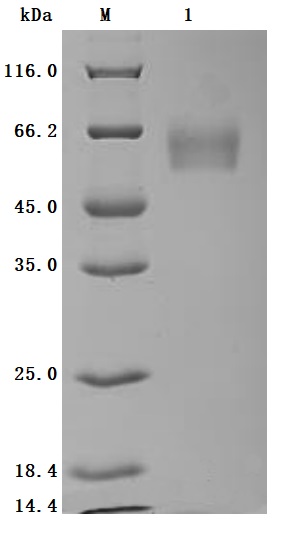The process for generating the recombinant human CEACAM8 protein includes cloning the target gene, constructing the plasmid, expressing the protein, and purifying the protein. The expression region responding to the 35-320aa of the human CEACAM8. The protein is fused with a C-terminal 10xHis-tag. Its expression system is a mammalian cell line. The final product is purified through Ni-NTA affinity chromatography. Its purity surpasses 95% as assessed by SDS-PAGE, and endotoxin levels are less than 1.0 EU/μg as determined by LAL assays. ELISA confirms its binding activity with the CEACAM8 recombinant antibody (CSB-RA005168MA1HU), with an EC50 of 19.38-21.68 ng/mL.
Human CEACAM8, also known as CD66b, is a glycosylphosphatidylinositol (GPI)-anchored membrane glycoprotein that plays a crucial role in the immune response, particularly in neutrophil activation and inflammation [7]. CEACAM8 is predominantly expressed on human neutrophils and is stored in specific granules, where it serves as a marker for neutrophil activation and degranulation [5][6]. Upon stimulation, CEACAM8 is rapidly mobilized to the cell surface, facilitating various immune functions, including adhesion and the production of reactive oxygen species [4].
In addition to cell adhesion, CEACAM8 also modulates immune responses. Soluble CEACAM8 can interact with CEACAM1, inhibiting TLR2-triggered immune responses, which suggests a regulatory function in inflammation [4]. This interaction highlights the importance of CEACAM8 in the communication between neutrophils and other immune cells, thereby influencing the overall immune landscape during inflammatory processes [3]. Furthermore, CEACAM8 has been implicated in various pathological conditions, including systemic lupus erythematosus (SLE), where it is released in response to extracellular chromatin, amplifying the inflammatory response [1]. Moreover, CEACAM8 has been associated with inflammation and immune cell infiltration in various cancers, serving as a potential biomarker for disease progression and response to therapy [2].
References:
[1] Cheng, Q., Chen, X., Xu, J., Chen, M., Zhang, P., Wu, H., … & Du, Y. (2022). Lncrna x‐inactive‐specific transcript is a potential biomarker related to changes in cd4+ t cell levels in systemic lupus erythematosus. Rheumatology & Autoimmunity, 2(3), 159-174. https://doi.org/10.1002/rai2.12048
[2] Guo, C., Zeng, F., Liu, H., Wang, J., Xue, H., & Luo, J. (2022). Establish immune-related gene prognostic index for esophageal cancer. Frontiers in Genetics, 13. https://doi.org/10.3389/fgene.2022.956915
[3] Ribon, M., Mussard, J., Semerano, L., Singer, B., & Decker, P. (2019). Extracellular chromatin triggers release of soluble ceacam8 upon activation of neutrophils. Frontiers in Immunology, 10. https://doi.org/10.3389/fimmu.2019.01346
[4] Singer, B., Opp, L., Heinrich, A., Schreiber, F., Binding-Liermann, R., Berrocal-Almanza, L., … & Slevogt, H. (2014). Soluble ceacam8 interacts with ceacam1 inhibiting tlr2-triggered immune responses. Plos One, 9(4), e94106. https://doi.org/10.1371/journal.pone.0094106
[5] Wu, H. and Han, F. (2023). Investigation of shared genes and regulatory mechanisms associated with coronavirus disease 2019 and ischemic stroke. Frontiers in Neurology, 14. https://doi.org/10.3389/fneur.2023.1151946
[6] Xiao, L., Xiao, W., & Lin, S. (2022). Potential biomarkers for active renal involvement in systemic lupus erythematosus patients. Frontiers in Medicine, 9. https://doi.org/10.3389/fmed.2022.995103
[7] Yang, L., Pan, X., Zhang, Y., Zhao, D., Wang, L., Yuan, G., … & Li, W. (2022). Bioinformatics analysis to screen for genes related to myocardial infarction. Frontiers in Genetics, 13. https://doi.org/10.3389/fgene.2022.990888








